Britannia Rules the Waves?
The Forgotten D-Day of 1545
By Ron Fritze
DATELINE: The Atlantic Ocean near England
June 17, 2008
The cruise has begun and so far we are having a wonderful trip. Our airline tickets were obtained by frequent flyer miles — and that means an awkward itinerary. Fortunately, although the flight was long, we had a smooth and uneventful trip.
We arrived in London about 11:15 a.m. on 12 June and reached our hotel about 1:30 p.m. It was a nice convenient location just off Russell Square, near the British Museum. We managed to stay up until almost 7, and then slept for over twelve hours. The next day I walked to see my publisher, Reaktion Books, to drop off a paper-copy of the manuscript for my next book and meet the managing director, Michael Leaman. Twylia walked to Selfridges for some shopping. I did a bookstore crawl along Charing Cross Road, which is something I call fun.
At 2 o'clock we got back together and walked down to Trafalgar Square, looking for fish and chips. Eventually we ended up at the Museum Pub outside the British Museum and had those fish and chips. Alas, they were mediocre. It is hard to find good fish and chips in inner London.
None Larger on the Seven Seas.
Next day we took the train to Southampton and boarded the ship. We are on the Independence of the Seas,
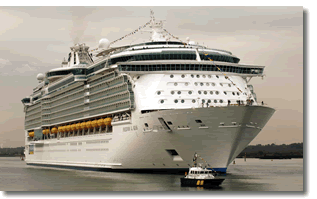 which we are told is currently the largest cruise ship operating. It is quite nice. Our room is a little larger and better laid out than the rooms we occupied last year on the Brilliance of the Seas. Vicky Robst, the cruise program administrator, is by far the best I have worked with. She had my seven lectures scheduled up-front for the sea days. I will deliver every lecture before we reach the port, which is most helpful for all concerned. They also have a nice conference center. My room holds about fifty people, but at my first lecture, eighty people crowded into the room with others turned away. Today my lecture attracted an audience of about forty. I have gotten a lot of nice compliments.
which we are told is currently the largest cruise ship operating. It is quite nice. Our room is a little larger and better laid out than the rooms we occupied last year on the Brilliance of the Seas. Vicky Robst, the cruise program administrator, is by far the best I have worked with. She had my seven lectures scheduled up-front for the sea days. I will deliver every lecture before we reach the port, which is most helpful for all concerned. They also have a nice conference center. My room holds about fifty people, but at my first lecture, eighty people crowded into the room with others turned away. Today my lecture attracted an audience of about forty. I have gotten a lot of nice compliments.
This cruise is heavily British. Our table has eight people including us. One couple is from Louisiana, another is English from Durham, and the third is Australian. This cruise has a lot of people in wheelchairs, all of whom appear to be British. The ship is completely handicapped accessible, which makes it nice for them. This cruise has few children, quite a contrast from the Christmas cruise we made to Panama where they were overrunning the ship.
The Independence sailed from Southampton. We were one of three cruise ships departing at the same time. We sailed down the Southampton Water and into the Solent through a winding ship channel. Initially I thought we would exit through the western end of the Solent, but we did a hard left and sailed into the area of the Solent known as Spithead. It used to be the great docking area of the Royal Navy off of Portsmouth, and in 1797 was the site of the beginning of the great naval mutiny that spread to the base at the Nore and the North Sea Squadron. If you've seen the 1962 movie Damn the Defiant! starring Alec Guinness in a pre Obi-Wan state, then you've got an idea of the tenor of those times.
Many Try — and Many Fail.
Less well known is the fact that this area was also the site of an attempted French invasion of England in 1545. It is well-known that England has not been invaded successfully since the Norman Conquest in 1066 — but not for lack of trying. Napoleon and Hitler both contemplated invasions of England, but never managed to make the attempt.
In the most celebrated attempted invasion, the Spanish Armada skirted the southern coast of England, but English ships prevented them from landing — and that was not their plan anyway. We remember the defeat of the Spanish Armada because it involved a dramatic sea battle followed by the scattered Spanish fleet retreating home by circumnavigating the British Isles and losing many ships and men in the process. One hundred and thirty Spanish ships sailed against England, while the defending English fleet consisted of one hundred ships.
Few, however, remember the French Armada of 1545, even though the French fleet consisted of one hundred and fifty warships with an additional twenty-five war galleys under sail, facing one hundred and sixty English warships.
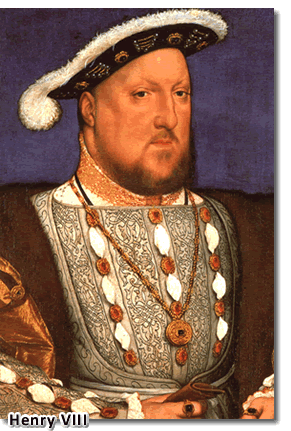 The ruler of England during this war was Henry VIII, whose life-long rival, Francis I of France, sent the great French Armada against England. What is also interesting for me about this episode in history is that most of the action took place in the waters approaching Southampton, the home port for this present cruise of the Independence of the Seas. I am given the opportunity to view the action of the past from a seaborne perspective of the present.
The ruler of England during this war was Henry VIII, whose life-long rival, Francis I of France, sent the great French Armada against England. What is also interesting for me about this episode in history is that most of the action took place in the waters approaching Southampton, the home port for this present cruise of the Independence of the Seas. I am given the opportunity to view the action of the past from a seaborne perspective of the present.
Europe in the first half of the sixteenth century was dominated by the military rivalry between Charles V, emperor of Germany and king of Spain, on the one side, and Francis I of France on the other. No match for either of these two superpower rulers, Henry VIII and England still made a convenient and coveted ally.
Henry Goes to Work Building Fortifications.
In 1540 it looked like Charles V and Francis I might forego their traditional rivalry against one another and try to invade England. To protect against such an attack, Henry VIII began a crash program of fortifying the southern coast of England. As it turned out, when the attempted French invasion occurred, most of the action was focused on the coast of Hampshire, a county in the center of England's southern coastline. Hampshire includes the Isle of Wight, a picturesque island of one hundred fifty square miles just three-to-four miles off the mainland.
The body of water separating the Isle of Wight from the mainland is known as the Solent. The area by Portsmouth is known as Spithead, one of the great anchorages of the Royal Navy in the age of sail. An estuary extends up the Solent and leads to the port of Southampton. It is known as Southampton Water.
The Solent and Spithead have channels for ships, but there are also areas of sandy shallows that make navigation by larger ships dangerous or impossible. The western end of the Isle of Wight has a rocky outcrop known as the Needles. Across the channel is a sandbar where rocks project outward, so that the western entry to the Solent is quite narrow. The Isle of Wight is now a resort area, but in the sixteenth century it was an area of farmers with their pastures and fishermen with their boats. Many of its beaches are backed by steep cliffs, which make them highly unfavorable for an amphibious landing. The southern part of the island is hillier.
Prior to 1537, the coastline of Hampshire possessed only three fortifications: the castles at Southampton and Portsmouth, and Carisbrooke Castle on the Isle of Wight. Within a few years, eight new fortifications were added under Henry's ambitious program. On the mainland another castle was constructed close to Portsmouth, which was already a naval yard, while two more forts were raised to guard the approach to Southampton, one at Netley and the other at Calshot. The western entrance of the Solent saw a castle built at Hurst on the mainland. On the Isle of Wight opposite to Hurst, another castle was built at Yarmouth. Two forts guarded the estuary at Cowes leading to Newport on the Isle of Wight. Finally, a fort guarded the beach at Sandown on the eastern end of the Isle of Wight. Similar building projects took place up and down the coast. It all cost a tremendous amount of money and forced Henry to sell off much of the monastic land and property he had confiscated between 1536 and 1540.
The Whims of War Batter Europe.
By 1542, however, it appeared that things on the Continent had returned to normal. The Emperor Charles and France went to war against one another on 30 July 1542, basically on personal whim as war in those days was truly the sport of kings. Henry VIII and England joined the Emperor in war with France in late June 1543.
The plan for the summer of 1544 was for Henry VIII and Charles V to send large armies in simultaneous attacks on Paris. The French
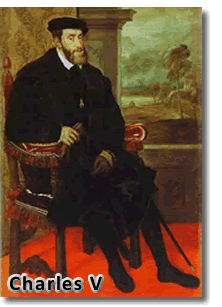 tried to detach Henry and Charles from their alliance. Henry toyed with the idea, but instead attacked Boulogne, deeming it an easier goal than the planned march on Paris. Meanwhile the Emperor proved receptive to French overtures and made peace on 18 September 1544 at the Peace of Crépy. The English, however, had captured Boulogne a few days earlier on 14 September. Henry VIII left a garrison of three thousand three hundred men behind to secure his new conquest — and went home. With the Emperor and Francis I at peace, England now found itself fighting alone against a much more powerful France. It was not a good place to be.
tried to detach Henry and Charles from their alliance. Henry toyed with the idea, but instead attacked Boulogne, deeming it an easier goal than the planned march on Paris. Meanwhile the Emperor proved receptive to French overtures and made peace on 18 September 1544 at the Peace of Crépy. The English, however, had captured Boulogne a few days earlier on 14 September. Henry VIII left a garrison of three thousand three hundred men behind to secure his new conquest — and went home. With the Emperor and Francis I at peace, England now found itself fighting alone against a much more powerful France. It was not a good place to be.
The immediate goal of the French was to recapture Boulogne, but their efforts failed. So Francis I decided to give Henry VIII a taste of his own medicine. His plan was to gather a great fleet and launch an invasion of England with the intention of capturing either an English port or the Isle of Wight. That would secure for France a base on English soil for further attacks, and perhaps provide leverage to get the English to give back Boulogne.
In June 1545, one hundred fifty warships and twenty-five war galleys were joined with sixty transports carrying sixty thousand troops. The force mounted by Francis I was twice the size of the army carried by the Spanish Armada. Admiral d'Annebault commanded the great French fleet.
The English Rise to the Defense.
To meet the French threat, Henry VIII put one hundred twenty thousand men under arms. They were divided into four companies of thirty thousand troops each. Charles Brandon, the Duke of Suffolk and brother-in-law to Henry VIII, commanded the company protecting Sussex, Kent, and Hampshire. The English fleet consisted of sixty royal ships, several of which, like the Great Harry, were larger than the largest French ship. Another one hundred private ships joined the English fleet, so that in the final tally, one hundred sixty English warships faced one hundred seventy five French.
To forestall the French invasion, the Lord Admiral John Dudley, Lord Lisle, launched a preemptive raid of the French anchorage at Le Havre, but did not manage to inflict any serious damage.
The French armada sailed against England on 16 July 1545, arriving at the Solent on 18 July. A few French ships detached from the main fleet and attempted a landing at Brighton, but were driven off. Henry VIII had come down to Portsmouth to review his defenders. He also got to review the French warships, which rounded St. Helen's Point with boats in front taking soundings. Eventually the French formed a line three miles long, extending almost to Ryde in the west and reaching east to Brading Harbor.
Hot Fire in the Calm Breeze.
Nineteen July began as a sunny, entirely calm day. The situation was bad for the English as it left them completely becalmed, allowing the twenty five French galleys to attack at will. Each galley carried a gun in its bow, enabling the French to approach the English line of battle with guns blazing. With most of their guns broadside, the English ships, stalled in the calm breeze, could not bring their firepower to bear on the enemy. The stationary English ships made easy targets, while the mobile French galleys could elude attack.
The French poured cannon fire into the English, severely damaging the Great Harry to the point it was in danger of sinking. Then, later that morning, their situation in peril, the English felt the breeze pick up behind them. At last, the defenders could fight back. Their frigates sailed into the fray to engage the enemy galleys. All that saved the galleys from destruction over the next hours was the earlier advance of the French line of battle, which provided the fleet some defense.
The English navy's hope was to get the French to engage them within range of the cannons at the fortress at Portsmouth. So they drew back. But the French declined to press forward. As a result, the engagement ended with insignificant losses for either side.
The only exception was the sinking of the Mary Rose, although she did not go under as a result of enemy action. Instead, she fell to the folly of her own crew.
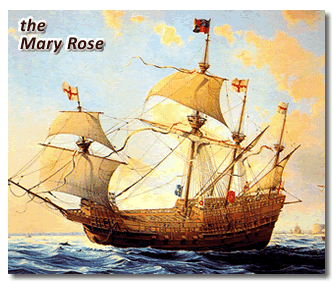 It happened this way. The Mary Rose was sailing with its lowest gunports open. The inexperienced commander, Sir George Carew, led a crew that was both arrogant and inexperienced. Racing the ship into battle, the helmsman took a sharp turn in the wind, causing the ship to lean, and putting the open gunports under water. The waters rushed into the doomed Mary Rose, causing her to sink with the loss of five hundred men. All of this took place under the eyes of a chagrined Henry VIII. And all this before noon.
It happened this way. The Mary Rose was sailing with its lowest gunports open. The inexperienced commander, Sir George Carew, led a crew that was both arrogant and inexperienced. Racing the ship into battle, the helmsman took a sharp turn in the wind, causing the ship to lean, and putting the open gunports under water. The waters rushed into the doomed Mary Rose, causing her to sink with the loss of five hundred men. All of this took place under the eyes of a chagrined Henry VIII. And all this before noon.
Will the English Take French Bait?
So, the afternoon arrived and further warfare loomed. Admiral d'Annebault wanted to draw the English fleet into a full action. To goad them to come out, he ordered three landings on the Isle of Wight with the design to burn some farms and villages in the Point St. Helen's and Bembridge areas. English troops on the island resisted fiercely, but were unable to dislodge the largest French force. Despite the dramatic ploy by their enemy, the English fleet in Portsmouth refused to take the bait, and even withdrew further into the harbor to prevent another attack by the galleys.
Then night fell upon the battle.
Admiral d'Annebault held a council of war on 20 July. Some officers suggested that the French fleet push its way into Portsmouth harbor, destroy the English fleet there, and capture Portsmouth. Such an attack was not feasible, other senior officers countered. The French pilots informed d'Annebault that he could only advance into the channel with four ships abreast, and even then it would be a treacherous passage through a vicious tidal current. The admiral thought they were mistaken cowards. He dispatched rowboats to measure the channel, and discovered that the situation was even worse. The French ships would only be able to advance single file. An attack upon Portsmouth was impossible.
With more than enough troops onboard his ships to win the day, Admiral d'Annebault's best move at that point would have been to land on the Isle of Wight and capture it. Instead, he declined the obvious opportunity, deciding instead to sail to another point on the English coast. Before he could depart, however, his fleet needed water, so on 21 July his ships sailed to Shanklin Bay near Sandown. The French landing party found the task of replenishing their water supply to be slow and tedious. The commander of the party, the Chevalier d'Eulx, took some men inland to look around — and was promptly ambushed and killed by the waiting English defenders. Forced to withdraw, the French failed to take on sufficient water, and then weather conditions forced them to make an anchorage near Chichester.
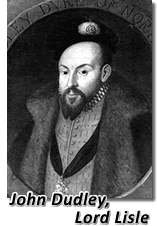 The English admiral John Dudley, Lord Lisle, asked Henry VIII's permission to attack the vulnerable French fleet on 22 July. His request was granted, but before the English could attack, spies managed to warn d'Annebault of the enemy's plans. Ordering his fleet to sail for the high seas, he made his way across the channel to Boulogne. There he joined the French forces in their siege of the town that the English army had captured the previous September.
The English admiral John Dudley, Lord Lisle, asked Henry VIII's permission to attack the vulnerable French fleet on 22 July. His request was granted, but before the English could attack, spies managed to warn d'Annebault of the enemy's plans. Ordering his fleet to sail for the high seas, he made his way across the channel to Boulogne. There he joined the French forces in their siege of the town that the English army had captured the previous September.
The Winds of War Shift in England's Favor.
Admiral d'Annebault dropped off seven thousand men to help with the siege and also relieve his ships of overcrowding. He then sailed back to the English coast, attempting a landing at Seaford near Lewes. The English were ready, and the winds of war blew good fortune their way. The French were driven off with great losses.
The French fleet retreated to the French coast, while the English fleet proceeded to escort supplies for Calais. Both fleets cruised the English Channel during an extraordinarily hot summer. But by 15 August, the opposing fleets were face-to-face along the English coast. They came together in battle once again, this time at Shoreham by Beachy Head, with the French possessing the advantage of the wind.
The two fleets engaged in indecisive fighting until nightfall, at which point they broke off. Both fleets anchored with an expectation of resuming the fight the next dawn. But when a good breeze came up during the night, the French chose to retreat. Plague had broken out on their ships, depleting their will and ability to fight.
Arriving at the mouth of the Seine at Le Havre, the French fleet set anchor. There English scouting vessels observed the devastation wrought by disease as body after body was taken off the ships.
Let's End this Costly Thing.
Not immune to the plague, the English suffered losses, too, but not so severe as their enemy. They managed to mount a raid of the coast of Normandy on 3 September. It was the last naval action of the campaign. Disease had so incapacitated the French fleet that the English were left in command of the sea, although they had not won a military victory. Boulogne was saved for the English, and both countries sought to end the costly and ineffectual war.
The treaty of Campe, also known as the Treaty of Ardres, followed on 7 June 1546. England kept Boulogne for eight years. When the French regained it from Henry,
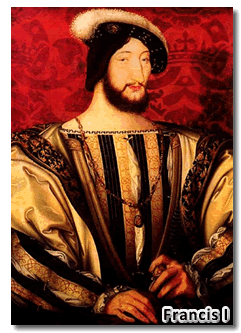 Boulogne was returned with new and improved fortifications, built at great expense by the English king, something he had also done when he captured Tournai. It seems that a good way to get your cities fortified was to let Henry VIII capture them.
Boulogne was returned with new and improved fortifications, built at great expense by the English king, something he had also done when he captured Tournai. It seems that a good way to get your cities fortified was to let Henry VIII capture them.
The Anglo-French War of 1543-1546 has been rightfully considered Henry VIII's most wasteful and capricious campaign. Nor did the French cover themselves in glory. They lost Boulogne, failed in their campaign to recapture it militarily, could not seize the Isle of Wight, and were unable to engage the English fleet in a decisive battle. The war's only distinction was Henry VIII's capture of Boulogne, but it remained under English rule for less than a decade.
History Chooses to Remember another Battle.
Otherwise, no great battles were fought. The two great fleets of France and England hesitated to risk all in a great sea-battle. And as a result, the defeat of the French Armada of 1545 is largely forgotten, while the defeat of the smaller Spanish Armada of 1588 lives on in people's memories as one of the epic naval battles in history.
Now, back in 2008, comfortable on a luxury liner, we land in Gibraltar. Our plan is to go to the top of the Rock and visit the Barbary Apes living there. I hope to get some pictures. Twylia and I have a bet as to which of us will get bit by one of these Gibraltar monkeys. She thinks it will be me. I think it will be her. I'll let you know how that turns out.
Click on the black panther to read Ron Fritze's pre-cruise essay,
"Toward the Western Mediterranean: Cruising for Enlightenment."
|




